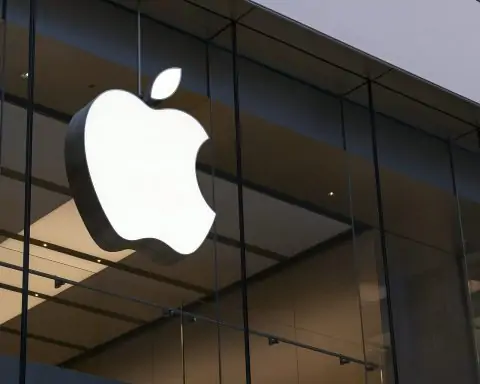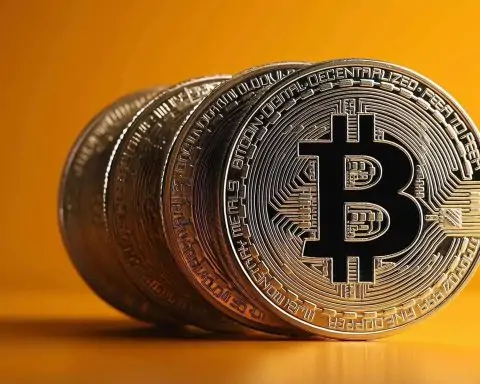- Fixed Supply Scarcity: Bitcoin’s code enforces a hard cap of 21 million coins, with mining rewards halving roughly every 4 years. This built-in scarcity is a core bullish argument – proponents say that as more dollars are printed, Bitcoin’s fixed supply makes it a natural hedge [1].
- Debt & Inflation: U.S. federal debt has nearly doubled (~+99%) in the past decade, now exceeding $36 trillion [2] [3]. The fiscal 2025 deficit alone was about $2 trillion (first 11 months) [4]. Such massive deficits and a rising M2 money supply raise inflation concerns, fueling the “debasement trade” into scarce assets like gold and Bitcoin [5] [6].
- Bullish Forecasts: One Motley Fool analyst predicts Bitcoin could triple by 2030 (to around $375,000) as fiscal pressures mount [7]. VanEck’s Matthew Sigel similarly ties Bitcoin to gold’s rise: he forecasts ~$644,000 by the 2028 halving (about +420%) if Bitcoin captures half of gold’s store-of-value market cap [8]. BlackRock’s Rick Rieder recently echoed that Bitcoin can serve “like gold” as a hedge against currency debasement [9].
- Gold vs Bitcoin: In 2025 gold has outperformed Bitcoin, challenging the crypto narrative. For example, a gold ETF (GLD) was up ~40% YTD in Sept. 2025 versus Bitcoin’s ~19% gain [10]. Gold is enjoying central bank buying (record purchases in 2024) and a reputation as a “stable hand” against inflation [11]. Some analysts note Bitcoin’s huge decade-long return (CAGR ~85% vs. gold’s ~11% [12]) but also its volatility: Bitcoin crashed ~70% during 2022’s inflation spike while gold climbed [13]. Deutsche Bank analysts suggest Bitcoin could become a reserve asset alongside gold by 2030 [14] – a sign that the debate isn’t settled.
- Institutional Flow and ETFs: 2025 saw strong institutional moves: U.S. spot Bitcoin ETFs launched in 2024, and by late 2025 the SEC eased rules for crypto funds [15] [16]. Dozens of new crypto-ETPs are planned (including multi-coin funds). This “boom time” for crypto ETFs should broaden access to Bitcoin for pension funds and big investors [17] [18]. Some believe these flows could keep Bitcoin’s bull run alive.
- Critics and Cautions: Not everyone is convinced. JPMorgan boss Jamie Dimon recently warned that if inflation stays “a little bit stuck” (~3%), the Fed may be unable to cut rates further – an outcome that would likely cool demand for speculative assets like Bitcoin [19]. Economist Dean Baker (CEPR) argues that crypto’s speculative gains inject “purchasing power without productive output,” likening crypto profits to new deficits that could stoke inflation [20]. A 2025 Investopedia analysis notes Fed research indicating Bitcoin’s fixed supply might even trap governments in a “balanced-budget trap,” making perpetual deficits hard to finance [21]. In short, critics say Bitcoin can’t magically solve fiscal problems – as one article put it, proposals to use Bitcoin to eliminate debt face “mathematical and conceptual” problems [22] [23].
- Stocks vs Crypto: Even Bitcoin bulls use caution in practice. Motley Fool’s Stock Advisor (which published the 3X Bitcoin forecast) did not include Bitcoin in its own top-10 picks for 2025–26 [24]. Their message: certain high-growth stocks (like Netflix and Nvidia in past cycles) can “crush” market returns, so investors might do better with selected equities than pure crypto. (Indeed, Fool discloses it does hold Bitcoin, but still separates it from their strongest stock recommendations [25].)
Bitcoin’s Built-In Scarcity
Bitcoin’s 21-million supply cap is coded into its software – no authority can issue more coins. This is enforced by periodic halving events (next halving ~April 2028), which cut the miner reward in half and slow new issuance [26] [27]. In effect, new supply is constantly shrinking. Bulls argue this makes Bitcoin a unique asset: as currencies inflate, each coin’s scarcity should boost its value. Motley Fool notes, “owning an asset that can’t be debased” is a compelling proposition [28].
But scarcity alone isn’t a guarantee. Past cycles show halving-driven bull runs (Bitcoin’s price soared after the 2016 and 2020 halvings), but each cycle has also included long bear markets. Critics point out that even “hard money” like Bitcoin depends on continued demand – if faith wanes or regulation tightens, scarcity doesn’t automatically translate to price. For now, scarcity remains the core bullish thesis: against a backdrop of trillions more USD in circulation, Bitcoin offers a predictable, finite supply [29] [30].
Debt, Deficits and the “Debasement” Trade
The term “debasement trade” (recently coined in finance media) refers to moving money into hard assets to hedge against fiat currencies losing value. Gold and Bitcoin are both beneficiaries. The Guardian reports investors are pouring funds into gold, Bitcoin and even select stocks amid fears governments will run up debt without raising taxes [31]. In the U.S., debt has ballooned: federal debt crossed $36 trillion in 2025 [32], roughly doubling since 2015 [33]. Annual deficits remain in the trillions. These trends coincide with a massive expansion of M2 (broader money supply), stoking inflationary worries.
Proponents of Bitcoin argue the math of money-printing favors crypto. As The Motley Fool article notes, higher deficits and bigger M2 “boost” the case for Bitcoin’s limited supply [34]. A CoinReporter piece likewise observes that on Oct. 10, 2025 gold and Bitcoin surged together as U.S. debt exceeded $35 trillion, suggesting investors were seeking scarcity in both assets [35].
However, some economists beg to differ on the narrative. In Investopedia, economist Dean Baker warns that “crypto… without producing any actually useful product, we should see it as a potential source of inflation similar to large budget deficits” [36]. Others note stablecoins (dollar-pegged tokens) are ironically helping fund U.S. debt: around $250 billion of stablecoin value is invested in Treasuries (Tether alone holds ~$120 billion) [37]. In short, crypto’s impact on deficits is complex. It can undermine fiscal control (if people use crypto instead of fiat), but it also channels money into government debt via tokenized dollars [38] [39].
JP Morgan analysts and a Deutsche Bank study have even suggested Bitcoin might sit on central bank balance sheets by 2030, echoing gold’s role [40]. As one DB report notes, in a “post-central-bank era,” Bitcoin’s programmability and global reach could let it mirror gold’s inflation-hedge function [41] [42].
Bullish Price Forecasts vs. Cautionary Voices
The debate over Bitcoin’s future price is polarized. On one side, analysts see clear catalysts: fixed supply, looming halvings, and massive fiscal deficits argue for higher BTC prices. Neil Patel (Motley Fool) puts it bluntly: “I predict… the top cryptocurrency will triple by 2030 to $375,000.” He calls such gains “not at all a shock” given ongoing fiscal mismanagement [43]. VanEck’s Matthew Sigel goes further: by tying Bitcoin to gold’s rally, he now targets about $644,000 by the 2028 halving (roughly a 420% rise) [44]. Sigel’s thesis is simple: young and emerging-market investors increasingly prefer a digital store of value, and Bitcoin should claim half of gold’s market cap [45] [46]. If true, this makes Bitcoin’s upside comparable to gold’s recent 50% surge.
By contrast, skeptics urge caution. Record price rallies often invite reversals. The Benzinga columnist Kenneth Rapoza notes that as of late 2025, “Bitcoin just does not come close to gold” as an inflation hedge [47]. He points out gold’s ETF (GLD) is up >40% YTD while Bitcoin is only up ~19% [48]. And during 2022’s inflation shock, gold prices rose while Bitcoin plunged about 70% [49].
Moreover, big finance figures are sounding warnings. JPMorgan CEO Jamie Dimon cautioned that sticky inflation (~3%) may force the Fed to pause cuts – “hard for the Fed to cut more” if inflation “does not go away,” he said [50]. This is bearish for crypto: past Bitcoin rallies were often fueled by expectations of easy Fed policy. Another caution: if rates stay higher, risk assets like Bitcoin may not get the anticipated tailwind. (Indeed, after a 25-basis-point Fed cut in Sept. 2025, Bitcoin briefly jumped to ~$117,500; but Dimon’s comments suggest those moves might not sustain if cuts stall [51].)
BlackRock’s Rick Rieder offers a more balanced view. He agreed Bitcoin shares qualities with gold – on CNBC he said Bitcoin is “a good hedge against currency depreciation” [52] – but he also emphasizes diversification. In the New York Times and elsewhere, Rieder has noted that Bitcoin’s fixed cap and digital nature help its long-term case, even if short-term volatility remains.
Bitcoin vs. Gold: Diverging Paths
Comparing Bitcoin to gold is inevitable. Both are championed as “hard money” assets. Bitcoin advocates tout the 21M cap, while gold has ~244,000 tonnes above ground (with new mine supply of ~3%/year). In practice, money managers are favoring gold in 2025. Central banks from China to India are buying record amounts of gold, not Bitcoin [53].
Part of this is historical trust. Gold has millennia of reserve status; Bitcoin has only been around 15 years and only “serious” for about a decade [54]. As Ben Caselin (VALR exchange) put it, “Gold’s surge… reflects its enduring appeal as a safe-haven asset,” while Bitcoin remains a risky, younger asset [55].
On the other hand, Bitcoin’s 10-year returns are stunning. Its CAGR (~85%) dwarfs gold’s (~11%) [56]. This math underlies long-term bullish views: if Bitcoin can ride out volatility, it could greatly outperform gold over decades. Morgan Stanley’s Byron Wien famously said he’d own Bitcoin at $400k – although many of Wien’s past predictions have been off. Notably, JPMorgan’s analysis (cited in [21]) found Bitcoin undervalued relative to gold on a volatility-adjusted basis.
The truth may lie in diversification. AInvest’s analysis suggests in a “post-central-bank era” both assets play roles: gold for geopolitical/monetary shocks, Bitcoin for next-generation currency debasement hedge [57]. As they conclude, savvy portfolios may hold both: gold for stability and Bitcoin for long-term upside.
Institutional Adoption & ETFs
Beyond commodities, institutions are moving. After years of speculation, the US now hosts multiple spot Bitcoin ETFs (launched 2024). In Sept. 2025 the SEC further streamlined crypto funds: it allowed exchanges to use generic standards for Bitcoin and gold ETPs [58] and cut approval times from 270 to ~75 days for new crypto ETFs [59]. Dozens of filings (for altcoins like Solana, XRP, Cardano) are in the pipeline. As Reuters reports, Q4 2025 is expected to be “boom time” for crypto ETF launches [60] [61].
More inflows could buoy prices. Grayscale’s new Crypto 5 ETF (BTC, ETH, XRP, SOL, ADA) debuted the day after rules changed [62]. Pension funds and retail investors now have easier access to crypto via traditional brokerage platforms. On the flip side, critics worry loose standards could flood the market with speculative products. For now, analysts say institutional eyes on crypto is a bullish signal for prices – though it also ties crypto more closely to stock-market sentiment and regulatory fortunes.
Risks, Volatility and Regulatory Concerns
Despite the promise, Bitcoin is far from a sure thing. Its price remains extremely volatile – it can surge or crash based on macro news. For example, a U.S.–China trade shock or a regulatory crack-down (e.g. banning miners) could trigger sudden losses. Unlike stocks, Bitcoin pays no dividends or earnings; it lives purely on investor perception.
Regulatory risks are non-trivial. In 2025 the U.S. finally gave a green light to spot Bitcoin ETFs, but many countries still lack clear rules for crypto. Policy shifts (like Coinbase’s controversial crypto “biometric” news or China/India stances) can sway sentiment. Tax and regulatory uncertainties remain an issue; as Investopedia notes, crypto’s decentralized nature makes tracking tax revenue harder [63].
Another long-term risk: competitors. Ethereum, Solana, or yet-to-emerge blockchains could capture more of the crypto market. If a “better” digital gold arises, Bitcoin could lose mindshare. Additionally, potential central bank digital currencies (CBDCs) could erode the appeal of independent cryptos.
Motley Fool Stocks vs Crypto
Interestingly, the Motley Fool piece itself plays both sides. While it touts Bitcoin’s scarcity and predicts 3X gains [64], it also plugs its stock-picking service as a supposedly safer bet. Motley Fool’s Stock Advisor team says many tech stocks could still outperform the market – and Bitcoin didn’t even make their top 10 list [65]. They cite classic examples: a $1,000 Netflix pick in 2004 became ~$657,979 today, Nvidia $1,000 in 2005 became ~$1.1M [66]. The message is clear: stock market gems can multiply fortunes too, without the extreme volatility of crypto.
So for ordinary investors, the debate is: Do you believe in the “crypto future” enough to risk 2025–2030 on Bitcoin? Or would you prefer vetted companies and established ETFs? The Motley Fool suggests a mix: own some Bitcoin if you’re bullish, but also diversify into stocks with strong fundamentals [67].
Bottom Line
By 2030, Bitcoin could very well be far above today’s ~$120K price – doubling or tripling as bullish forecasts claim – if current trends continue. Supporters point to the next halving, relentless fiscal deficits, and evolving investor sentiment. But opponents remind us of Bitcoin’s crashes, competition (gold, other assets), and macro headwinds.
As always, no forecast is guaranteed. Bitcoin’s story remains a grand experiment: a new kind of money vying for global store-of-value status. Its built-in scarcity and growing acceptance give it upside, but its volatility and uncertainty warrant caution. Observers will keep watching debt levels, Fed policy, and market flows. Whether Bitcoin will triple in value or face turbulence is still an open question – one on which experts sharply disagree [68] [69].
Sources: We have cited a range of recent analyses and expert comments to present both sides. The bullish thesis and 2030 price targets come from financial analysts like Neil Patel (Motley Fool) [70] and Matthew Sigel (VanEck) [71], as well as market commentators from finance news outlets. Skeptical views are drawn from economists (e.g. Dean Baker) and institutional voices (Jamie Dimon) [72] [73]. Data on debt and deficits come from U.S. Treasury and Fed reports [74] [75]. We also cite reputable news sources (Reuters, Bloomberg, Guardian) and crypto research platforms to ensure a balanced perspective.
References
1. www.nasdaq.com, 2. www.investopedia.com, 3. www.nasdaq.com, 4. www.nasdaq.com, 5. www.nasdaq.com, 6. www.theguardian.com, 7. www.nasdaq.com, 8. www.financemagnates.com, 9. www.benzinga.com, 10. www.benzinga.com, 11. www.benzinga.com, 12. www.benzinga.com, 13. www.benzinga.com, 14. www.theguardian.com, 15. www.reuters.com, 16. www.bloomberg.com, 17. www.reuters.com, 18. www.bloomberg.com, 19. cointelegraph.com, 20. www.investopedia.com, 21. www.investopedia.com, 22. www.progressivepolicy.org, 23. www.investopedia.com, 24. www.nasdaq.com, 25. www.nasdaq.com, 26. www.nasdaq.com, 27. www.financemagnates.com, 28. www.nasdaq.com, 29. www.nasdaq.com, 30. www.investopedia.com, 31. www.theguardian.com, 32. www.investopedia.com, 33. www.nasdaq.com, 34. www.nasdaq.com, 35. www.coinreporter.io, 36. www.investopedia.com, 37. www.investopedia.com, 38. www.investopedia.com, 39. www.investopedia.com, 40. www.theguardian.com, 41. www.ainvest.com, 42. www.theguardian.com, 43. www.nasdaq.com, 44. www.financemagnates.com, 45. www.financemagnates.com, 46. www.financemagnates.com, 47. www.benzinga.com, 48. www.benzinga.com, 49. www.benzinga.com, 50. cointelegraph.com, 51. cointelegraph.com, 52. www.benzinga.com, 53. www.benzinga.com, 54. www.benzinga.com, 55. www.benzinga.com, 56. www.benzinga.com, 57. www.ainvest.com, 58. www.bloomberg.com, 59. www.reuters.com, 60. www.reuters.com, 61. www.reuters.com, 62. www.reuters.com, 63. www.investopedia.com, 64. www.nasdaq.com, 65. www.nasdaq.com, 66. www.nasdaq.com, 67. www.nasdaq.com, 68. www.nasdaq.com, 69. cointelegraph.com, 70. www.nasdaq.com, 71. www.financemagnates.com, 72. www.investopedia.com, 73. cointelegraph.com, 74. www.nasdaq.com, 75. www.investopedia.com










